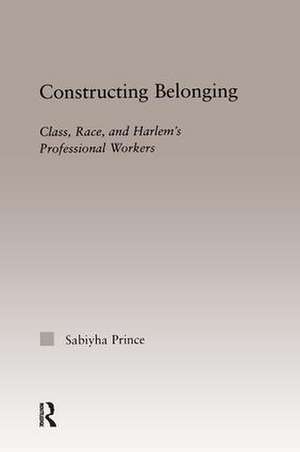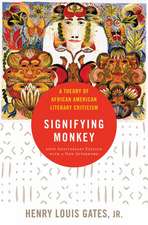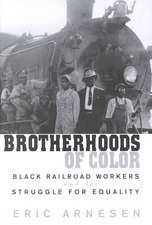Constructing Belonging: Class, Race, and Harlem's Professional Workers: Studies in African American History and Culture
Autor Sabiyha Robin Princeen Limba Engleză Paperback – 17 ian 2019
| Toate formatele și edițiile | Preț | Express |
|---|---|---|
| Paperback (1) | 356.44 lei 6-8 săpt. | |
| Taylor & Francis – 17 ian 2019 | 356.44 lei 6-8 săpt. | |
| Hardback (1) | 997.90 lei 6-8 săpt. | |
| Taylor & Francis – 30 oct 2003 | 997.90 lei 6-8 săpt. |
Din seria Studies in African American History and Culture
-
 Preț: 436.14 lei
Preț: 436.14 lei -
 Preț: 312.68 lei
Preț: 312.68 lei -
 Preț: 257.25 lei
Preț: 257.25 lei -
 Preț: 363.00 lei
Preț: 363.00 lei - 13%
 Preț: 307.76 lei
Preț: 307.76 lei - 26%
 Preț: 762.97 lei
Preț: 762.97 lei -
 Preț: 442.50 lei
Preț: 442.50 lei - 18%
 Preț: 1108.37 lei
Preț: 1108.37 lei -
 Preț: 433.86 lei
Preț: 433.86 lei - 18%
 Preț: 997.90 lei
Preț: 997.90 lei -
 Preț: 426.51 lei
Preț: 426.51 lei -
 Preț: 216.14 lei
Preț: 216.14 lei - 26%
 Preț: 929.16 lei
Preț: 929.16 lei -
 Preț: 436.14 lei
Preț: 436.14 lei -
 Preț: 449.41 lei
Preț: 449.41 lei -
 Preț: 436.14 lei
Preț: 436.14 lei -
 Preț: 198.19 lei
Preț: 198.19 lei - 26%
 Preț: 766.12 lei
Preț: 766.12 lei -
 Preț: 436.14 lei
Preț: 436.14 lei -
 Preț: 438.56 lei
Preț: 438.56 lei -
 Preț: 425.59 lei
Preț: 425.59 lei - 25%
 Preț: 500.68 lei
Preț: 500.68 lei - 26%
 Preț: 762.57 lei
Preț: 762.57 lei -
 Preț: 476.75 lei
Preț: 476.75 lei -
 Preț: 483.49 lei
Preț: 483.49 lei -
 Preț: 323.23 lei
Preț: 323.23 lei -
 Preț: 480.62 lei
Preț: 480.62 lei - 18%
 Preț: 998.88 lei
Preț: 998.88 lei -
 Preț: 393.53 lei
Preț: 393.53 lei - 25%
 Preț: 769.90 lei
Preț: 769.90 lei -
 Preț: 436.14 lei
Preț: 436.14 lei - 25%
 Preț: 513.61 lei
Preț: 513.61 lei - 12%
 Preț: 325.34 lei
Preț: 325.34 lei - 26%
 Preț: 762.89 lei
Preț: 762.89 lei - 18%
 Preț: 1106.02 lei
Preț: 1106.02 lei - 12%
 Preț: 312.43 lei
Preț: 312.43 lei - 26%
 Preț: 763.78 lei
Preț: 763.78 lei -
 Preț: 436.14 lei
Preț: 436.14 lei - 18%
 Preț: 943.45 lei
Preț: 943.45 lei -
 Preț: 452.99 lei
Preț: 452.99 lei - 34%
 Preț: 826.86 lei
Preț: 826.86 lei - 18%
 Preț: 996.33 lei
Preț: 996.33 lei -
 Preț: 490.25 lei
Preț: 490.25 lei
Preț: 356.44 lei
Nou
Puncte Express: 535
Preț estimativ în valută:
68.21€ • 71.13$ • 56.69£
68.21€ • 71.13$ • 56.69£
Carte tipărită la comandă
Livrare economică 20 martie-03 aprilie
Preluare comenzi: 021 569.72.76
Specificații
ISBN-13: 9781138971608
ISBN-10: 113897160X
Pagini: 184
Dimensiuni: 152 x 229 x 11 mm
Greutate: 0.45 kg
Ediția:1
Editura: Taylor & Francis
Colecția Routledge
Seria Studies in African American History and Culture
Locul publicării:Oxford, United Kingdom
ISBN-10: 113897160X
Pagini: 184
Dimensiuni: 152 x 229 x 11 mm
Greutate: 0.45 kg
Ediția:1
Editura: Taylor & Francis
Colecția Routledge
Seria Studies in African American History and Culture
Locul publicării:Oxford, United Kingdom
Cuprins
1. Race and Class in Manhattan and Harlem History 2. Locating Class and Race in Anthropology and History 3. Professionals, Entrepreneurs and Artists: Harlem's African American Professional-Managerial Workers 4. Work and its Impact on Income and Housing 5. Lifestyle, Consumption and Ideology 6. Negotiating Socioeconomics Boundaries in Kin Networks 7. Negotiating Socioeconomic Boundaries in Community Life 8. Conclusion: Race, Class, History and Identity

















